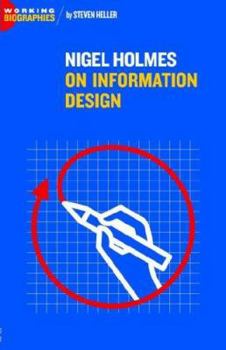Nigel Holmes On Information Design
Born 1942 in England M.A. degree in illustration from the Royal College of Art, London, 1966. He worked for Time Magazine from 1978 to 1994 in New York City as Executive Art Director: charts, covers, administration and Graphics Director his work has appeared in important magazines and publications such as American Health; American Lawyer; Amicus Journal; Attach (USAir magazine); Details; Discover; Business 2.0 (formerly eCompanyNow) (visual columnist);...
Format:Paperback
Language:English
ISBN:097747240X
ISBN13:9780977472406
Release Date:February 2006
Publisher:Jorge Pinto Books
Length:140 Pages
Weight:0.10 lbs.
Dimensions:0.3" x 5.5" x 8.5"
Customer Reviews
1 rating
Intrioduction by the Author (posted by the publisher)
Published by Thriftbooks.com User , 18 years ago
Explaining Explanation Graphics By Steven Heller Nigel Holmes did not invent pictographs, but by using them the way they were originally intended he has created a vigorous graphic language that is now part of the public's visual vernacular. The pictographic system was developed in the 1920s to provide accessible information to the masses while helping to increase visual literacy throughout the world. Inspired by this "Modern" (utopian) mission and influenced by its masters, in the mid-1970s Holmes introduced an array of inventive new pictograms and ways to use them as key graphic elements in what he dubbed "explanation graphics." This ultimately triggered what became a burgeoning practice of "information design" in magazines, newspapers, and other media. Since then, the almost limitless deluge of data in print, on TV and the web has heightened the flow of raw data and the designer's job to turn it into comprehensible information, often with wit and humor. Holmes has been one of its leading innovators. A graduate in 1966 from The Royal College of Art, in London, Holmes ran his own successful graphic design studio in England. In 1977 art director Walter Bernard hired him to work in the map and chart department at Time Magazine, where he ultimately became Graphics Director, a new title for a new kind of assignment. His colorful and witty pictorial explanations of complex themes - everything from arms build-up to economic decline - established a visual persona for Time that combined functionality with graphic charm. His methods earned him many imitators and some academic critics who argued that his over-simplified complexity produced less understanding than more. Holmes' method is not always apt for communicating all manner of information but neither is this approach dumbing down information either. Holmes believes the power of pictures and humor to help readers comprehend abstract numbers and difficult scientific concepts - as well as sort through layers of mumbo jumbo - has helped lessen the information glut. After sixteen years at Time Magazine, Holmes started his own explanation design company, which serves variety of clients, including Apple, Fortune, Nike, The Smithsonian Institution, Sony, United Healthcare, US Airways and Visa, and he continues to do graphics for publications such as Discover, Harper's, On Earth (NRDC), The New Yorker and The New York Times. He has written four books on aspects of information design, and also a series of really small books, The Smallest Ever Guides for Busy People, which explain difficult concepts in layman's terms. The first was about the Internet and is now in its 7th US edition. This was followed by The Smallest Ever Guide to Life Sciences (together with Juan Enriquez of Harvard University), and The Smallest Ever Guide to The Hydrogen Economy, for General Motors. His latest foray into information mastery Wordless Diagrams, was published by Bloomsbury in 2005. Also with his son, Rowland, Holmes prod




